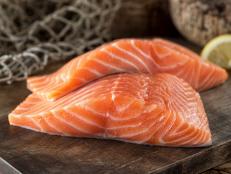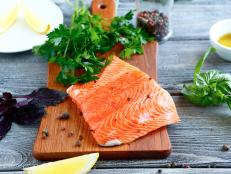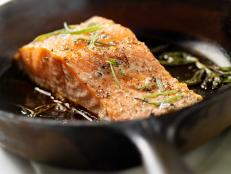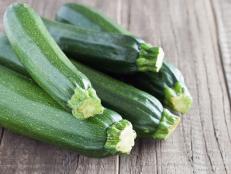How to Defrost Salmon
There are only three safe ways to do it.

jerrydeutsch/Getty Images
By Alice K. Thompson for Food Network Kitchen
Alice is a contributing writer and editor at Food Network.
Healthy, tasty and easy to cook: No wonder salmon is perennially popular with home cooks. Keeping some in the freezer means you can have excellent seafood meals between shopping trips. And the best news is that frozen salmon is often more economical and can be just as high-quality as what the fish counter sells as fresh. Here’s everything you need to know to thaw it quickly and safely for excellent eating.
How to Defrost Salmon
The USDA says there are only three ways to safely thaw foods, including salmon: in the refrigerator, in cold water or in the microwave.
How to Defrost Salmon In the Refrigerator
This is by far the easiest and safest method to thaw salmon and is best at preserving the flavor and texture of the fish. Just place the salmon on a plate or bowl to catch any liquid, cover it to prevent odors from escaping and place it in a cool part of your fridge. Small cuts will take overnight or 8 to 12 hours to thaw, while larger cuts or a side of salmon can take 24 hours.
How to Defrost Salmon In Water
Thawing salmon in water is the best choice if you don’t have the hours for fridge thawing. First place the salmon in one or more resealable bags (give each piece its own bag if possible), remove excess air and place the fish in a large bowl of cold water. It’s okay if the bags float a bit, but it will take longer for them to thaw; weight them down with a plate if you’re in a hurry. Change the water every 30 minutes to keep it at a safe temperature. Small cuts should defrost in 1 to 2 hours while larger cuts will take up to 4 hours. Drawbacks? This method can be cumbersome for larger cuts, and if water leaks into your sealed bags (which it often does) the quality of your fish will be slightly compromised. Try to position the sealed edge of your bags up, above the water, if possible.
How to Defrost Salmon In the Microwave
Turn to the microwave if you’re in a real hurry to defrost salmon. Remove the fish from any packaging, place it on a microwave-safe plate and cover it with a paper towel. Choose the defrost function and enter the weight. Check it every minute or so; remove it when it becomes flexible (a few icy spots are okay). Let it sit on the plate for a few minutes to become fully thawed and then cook it immediately. This method has two drawbacks: Microwaves deliver uneven heat, so you’ll likely have some over-thawed sections that will become dried out during cooking. And since the salmon will be fairly warm from the microwave it’s necessary to cook it immediately after thawing to prevent bacterial growth.
How to Defrost Salmon Quickly
Thawing salmon in the microwave on the defrost setting takes only minutes, but keep in mind that microwaves heat unevenly, so it’s likely that the texture of some portions of your fish will be compromised. The fish will also need to be cooked immediately to avoid the growth of bacteria. And for all defrosting methods remember that smaller cuts will thaw more quickly, so choose these if you think you’ll be time-pressed. In a real hurry? See below to decide if you even need to defrost your salmon.

alvarez/Getty Images
Can You Defrost Salmon on the Countertop?
The USDA says that you should never thaw any food on the countertop (or in a garage, basement or car). Frozen food must be kept at a safe, constant temperature of 40 degrees F or below to ensure that any bacteria present before it was frozen doesn’t begin to multiply.
Can You Cook Frozen Salmon Without Thawing It?
Yes, there are times you might not have to thaw salmon. If you’re poaching (cooking it submerged in liquid) or baking it, the constant, even temperature means you can start from frozen and just increase the cooking time until the center reaches a safe temperature. You’ll need to check it frequently, but you can estimate about 50 percent longer than the recommended time for thawed salmon. You can even pan-sear frozen salmon and, in some instances, cook it on the grill with a few modifications. Learn more in this article about cooking salmon straight from frozen.

Renee Comet
Up for trying a recipe created specifically for cooking frozen salmon? Food Network Kitchen developed Lemon-Butter Baked Frozen Salmon Fillets (pictured above) just for that.
Can You Freeze Salmon?
Salmon freezes well. In fact, most (but not all) salmon at fish counters has been previously frozen and thawed for display. Salmon from many wild fisheries is seasonal, so harvesting it and flash-freezing it makes sense for most of the catch. Only salmon labeled “fresh, never frozen” is guaranteed fresh-caught.
Repeatedly thawing and freezing salmon will degrade its flavor and texture, so it’s not recommended. That said, if your dinner plans change after buying some previously frozen salmon at the fish counter or thawing some yourself in the fridge, it is safe to refreeze it. (Don’t refreeze salmon thawed in water or the microwave, however; it may have elevated levels of bacteria.) Refreezing will cause some loss of moisture, so your salmon will be less succulent, but that’s probably preferable to throwing it out.
To freeze salmon, wrap it securely in plastic, then place it in a resealable freezer bag or wrap it in aluminum foil. Label the fish with the date and use it within 3 months for fresh, 1 to 2 months for salmon you’re refreezing.
Related Links:































































